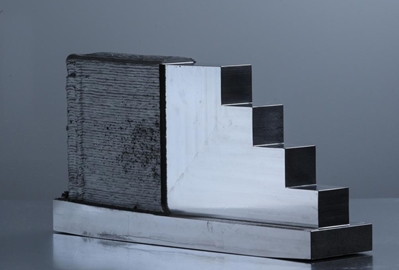With a focus on developing additive manufacturing of “extra large” metal components, a group of research institutes and companies from Laser Zentrum Hannover (LZH) and Germany’s Lower Saxony region have announced the joint development of a giant 3D printer. It can produce steel components weighing several tons – and is primarily intended to save resources in production.
XXL3DDruck project makes ship gearbox parts – weighing up to 3 tons – with laser-arc welding.
Manufacturing individual large-scale components is usually an energy- and material-intensive process. In the ”XXL3DDruck” project, scientists at LZH have joined forces with partners to develop and test a more resource-efficient way of producing XXL components. They produced parts of a ship gearbox housing with a mass of up to three tons layer by layer in an oversized 3D printer using a laser-assisted arc welding process.
The XXL printer occupies an installation space of 3m x 4.5m. It is used as a prototype for research and development purposes only, so far, and is located at the site of marine gearbox manufacturer Reintjes, in Hameln (Hamelin), Germany.
The printer uses laser-assisted arc deposition welding, a high-performance additive process method for metals that achieves high mass throughput. The group is able to apply up to 3.2 kilograms of steel per hour with the new printer.
The partners say that the new process “can reduce the use of material and energy compared to conventional manufacturing methods,” adding, “classically, individual molds are made for the components of marine gearbox housings. This work step is eliminated in additive manufacturing.”
Material and weight can also be saved because components can be redesigned and constructed differently – with hollow walls, for example. Laser-assisted arc deposition welding can also implement individual, component, and customer-specific design requirements.

Resources also saved
XXL printing conserves resources during production and later during the operation of the ship –essentially, if less material is used, the ship needs to accelerate less mass and thus also uses less fuel.
A part of a ship’s gearbox housing, which is currently still being manufactured, serves as a demonstrator. Through additive manufacturing, the project participants are aiming to “reduce the weight of a ship gearbox housing by several tons”.
The long-term goal for production is to reduce manufacturing and procurement time as well as to save raw materials such as steel by reducing the amount of material used per housing.The joint project XXL3DDruck (its full English title is Energy- and resource-efficient manufacture of large-scale products through additive manufacturing using the example of ship gear housings) was funded by the German Federal Ministry for Economic Affairs and Climate Action (duration 2019 – 2023).
The project was managed by Reintjes. The LZH was responsible for the development of the process technology. Eilhauer Maschinenbau took over the plant engineering of the XXL 3D printer. TEWISS – Technik und Wissen GmbH was responsible for building the print head and controlling the printer. The IPH – Institut für Integrierte Produktion Hannover developed an inline measurement technology for process monitoring.
Subscribe to AM Chronicle Newsletter to stay connected: https://bit.ly/3fBZ1mP
Follow us on LinkedIn: https://bit.ly/3IjhrFq
Visit for more interesting content on additive manufacturing: https://amchronicle.com


